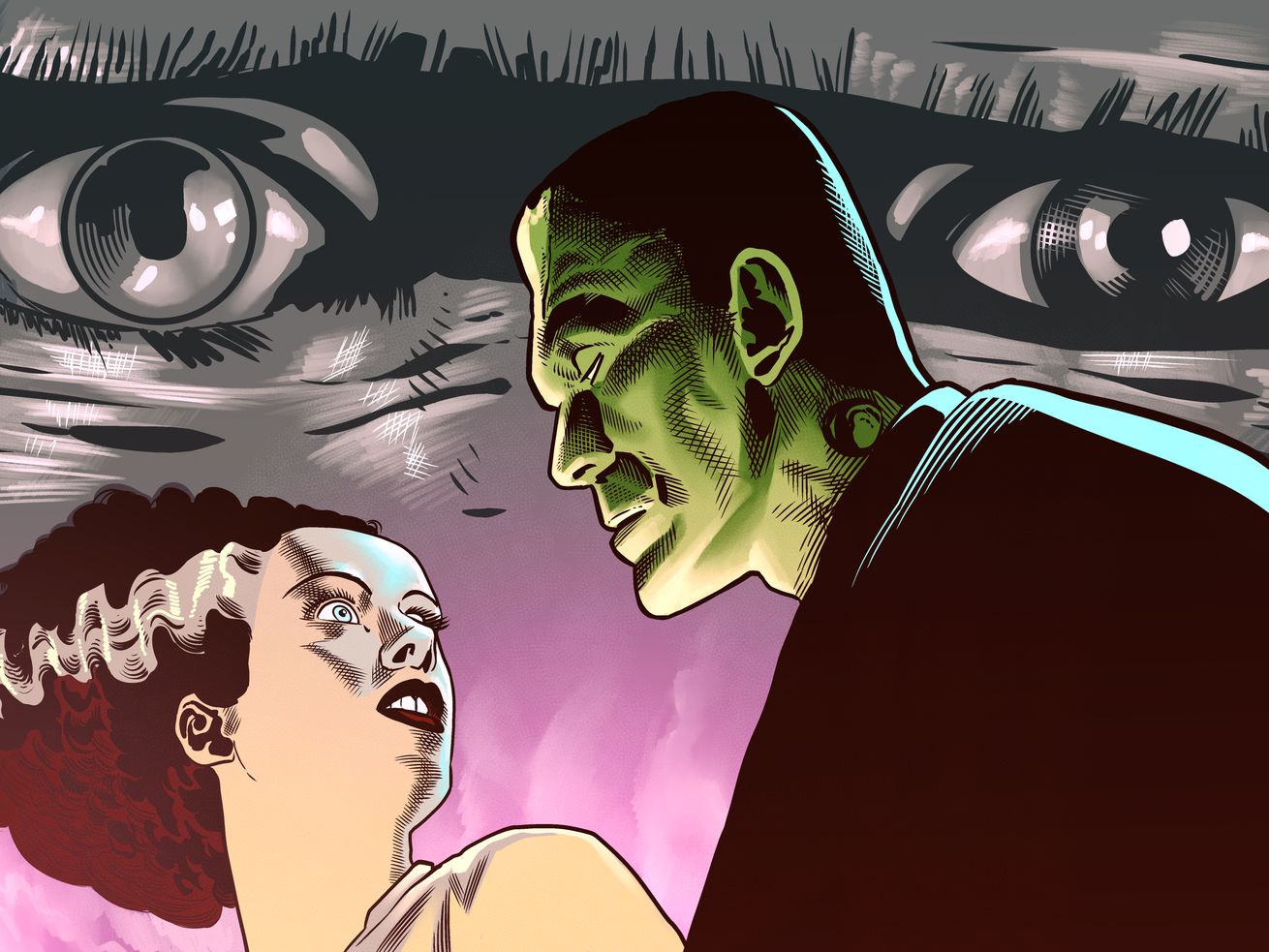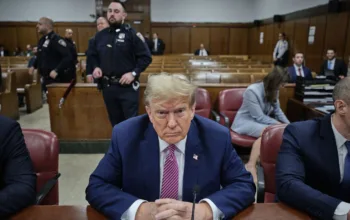The scariest movies have always been a dark mirror on Americans’ deepest fears and anxieties.
/cdn.vox-cdn.com/uploads/chorus_asset/file/21899595/VOX_The_Highlight_Box_Logo_Horizontal.png)
Part of the Horror Issue of The Highlight, our home for ambitious stories that explain our world.
A girl goes for a twilight swim just off a secluded beach. We see her from underneath the water, silhouetted between the sun and the sea. From this angle, she’s the picture of a tranquil bathing beauty enjoying a peaceful dip in the sparkling ocean just before sunset. Then we hear it: a sinister two-note bass theme as the camera approaches her from below.
She feels something, a tug on her leg that tells her something is very wrong.
Her face crumples into worry, then horror when it happens again, pulling her briefly under water. She screams, but her boyfriend is passed out on the beach, unable to hear her from just feet away; she tries to swim to safety but has no idea which direction to swim in. For a few terrifying moments, she’s flung about in the water, dragged under again and again by something unseen, something awful. Finally, with one last, dreadful scream, she vanishes below the surface.
The whole ordeal happens in just 40 seconds, but once those 40 seconds in Jaws (1975) are up, the audience’s illusion of the beach as just another vacation destination has been shattered — and, along with it, the idea that civilization itself can ever truly protect us. Amity Island, the quaint Atlantic tourist spot where Jaws takes place, represents the promise and prosperity of the American dream. But if one shark can chomp its way to chaos and carnage there, then perhaps, Jaws suggests, the American dream itself isn’t all that robust.
Jaws is famous for both singlehandedly creating the “summer blockbuster” mode of moviemaking and forever changing people’s perception of sharks, but its truest legacy is the metaphor of the shark itself: the omnipresent darkness lurking at the heart of Americana, reminding us that we are never truly safe.
Beginning with 1920’s The Cabinet of Dr. Caligari — widely considered to be the first horror film — the best horror films have functioned as a dark mirror, reflecting our own fears back to us through the lens of storytelling. They use allegory and symbolism to stand in for a whole host of social phobias, structural repression, and shared anxieties. Just as our readings of such stories can change over time, our relationship to horror films can shift. The scary figure in the woods can represent something very different depending on who’s looking at it, and when.
That’s why horror cinema through the ages can serve as a diary, a documenting of civilization confronting its fears of monsters both human and supernatural — fears of war, fears of nature, fears of extinction, and much more. “We make up horrors to help us cope with the real ones,” Stephen King writes in Danse Macabre, his 1981 nonfiction book on the genre. “With the endless inventiveness of humankind, we grasp the very elements which are so divisive and destructive and try to turn them into tools—to dismantle themselves.”
If horror helps us speak our fears aloud, a look back at a hundred years of seminal horror films reveals a civilization trying to come to terms with itself — for better and worse.
Prewar: Monsters and the monsters within us
Although horror has always been a prominent theme in folklore, fairy tales, and urban legends, horror as a genre arguably kicked off in 1764 with the publication of Horace Walpole’s The Castle of Otranto, the very first gothic horror novel. The story teemed with homoerotic symbolism and strange, otherworldly acts, and today is often read as an externalization of the author’s grappling with sexuality. From the time of its publication through today, horror has contained an element of internalized fears and phobias, shames and anxieties, made external and visualized. Sometimes we’re able to overcome them; sometimes they overcome us. And often, the “monsters” turn out to be regular people like Horace Walpole, grappling with his queer identity in a homophobic society.
The slippery concept of what makes a person “monstrous” has long been a central theme in horror, and it’s something that preoccupied horror creators during the first decades of moviemaking. Throughout prewar Hollywood, it was the subject of an onslaught of beloved horror films, many produced by Universal Studios and played by celebrity character actors such as Bela Lugosi, Boris Karloff, and Lon Chaney Sr. and Lon Chaney Jr.
“This was an oblique reaction to the bleak horrors of the trenches and the death tolls in the First World War,” horror expert and Southern Methodist University film professor Rick Worland points out. The experiences of many scarred, disfigured, and traumatized veterans, Worland says, were transmuted into monster films — the Phantom in Chaney Sr.’s Phantom of The Opera (1925), for instance.
Perhaps no film more fully communicates this anxiety than Tod Browning’s Freaks (1932), about a community of sideshow performers who fall prey to a glamorous but villainous woman who exploits them. Freaks was an early example of the aesthetic of camp on film, as well as two prevalent cornerstones of horror: its entanglement as a genre with themes of queerness and social ostracism, and the embedded expectation that audiences will feel more empathy for the film’s ostensible freaks and misfits than they will for anyone else onscreen.
The emphasis on the monstrous was partly a reaction to the sheer monstrosity of the war itself. “[There was also] a kind of skepticism about science and technology, because World War I was a modern, 20th-century war,” Worland says. “This was the first war where the submarine, the machine gun, and the tank were all used extensively.” James Whale’s adaptation of Frankenstein (1931), with its morality tale about a science experiment gone horribly wrong, arguably embodies the era’s unease about technology — a theme that would become even more prominent in horror after World War II.
Along with skepticism over technology, Americans grappled with a new age of industrial advancement and the shock of adjusting to life in the 20th century. In a turn away from modernity itself, many of the most popular films blended a mix of old-world and historical elements. The title characters in The Mummy (1932), Dracula (1931), and Jacques Tourneur’s Cat People (1942), for example, all are modern transplants who come from “old” worlds. Cat People, in particular — a shadowy noir horror with suspenseful scenes that influenced Hitchcock, as well as many other filmmakers — has a highly atypical “monster” for its era: a gorgeous young blond named Irena who’s terrified of her own reflection. A Serbian seamstress fleeing her own fate with vague stories of witches and cat people, Irena thinks she’s outrun the curse when she settles in New York and finds love.
“You’re in America now,” her fiancé tells her at one point. “You’re so normal.” But “normal” in America, or at least in an American horror story, is always one wrong street away from nightmarish. The nightmare in Cat People goes even deeper than typical modern anxiety; in the landscape of Tourneur’s New York, even your own shadow could turn against you.
In other words, by the end of the era, it wasn’t enough to simply recognize and sympathize with the humanity of the monster. Viewers had to accept that the monster might be them.
The postwar Atomic Age: Environmental, technological, and alien monstrosities
/cdn.vox-cdn.com/uploads/chorus_asset/file/22921837/Godzilla.jpg)
The atomic bombings of the cities of Hiroshima and Nagasaki, acts of real-world horror at the close of World War II, left psychic scars on the landscape of Japan and the landscape of horror cinema. The entire genre evolved, immediately and irrevocably, in response. If prewar scary movies had consisted primarily of stories of regular people battling internal monsters, postwar horror was consumed with community, with concern for society in the wake of new technological threats.
As the world settled into the Cold War, hundreds of sci-fi and horror films questioned humans’ ability to care for the planet, ward off environmental and nuclear disaster, prevent invasions, and generally stop themselves before going too far. New monsters, ranging from alien to subterranean, haunted movie houses. Legions of oversized killer rodents, insects, cryptids, and toxic-waste monsters emerged from the fictional depths and ran rampant. Nearly all the films arrived with the same basic premise: Overzealous humans created or accidentally unearthed these abominations and must figure out how to destroy them without causing future planetary harm.
One of the first hit creature features of the 1950s, 1954’s Creature from the Black Lagoon, is arguably the last of the lineage of great Universal movie monsters. It serves as a transitional narrative, with a plot that feels like a throwback to the Amazonian adventure fantasies of the ’20s and ’30s but still delivers a cautionary tale about environmental overreach.
The same year the Creature wowed audiences with its underwater skills, Japan processed unfathomable cataclysmic tragedy through the creation of a new monster: Gojira (1954), a.k.a. Godzilla. Godzilla directly manifested Japan’s nuclear anxieties: He arose from the deep to prowl the earth only after being disturbed by hydrogen bomb tests. Now he possesses strange atomic powers, including the ability to exhale enormous amounts of radiation — a post-nuclear dragon.
Godzilla was an odd horror villain because he wasn’t always a villain. He both embodies the horror of nuclear war as experienced by the country that survived it, and the hope that humanity can overcome and build something better out of that atrocity.
If Japan was creating hope from nuclear monsters, Hollywood was busy creating dread from alien invasions and technological monstrosities. While most of those atomic-age monsters weren’t human, increasingly, fears of modernization and disturbing scenes of suburbia — of idyllic towns and beatific children who are just a little too idyllic and beatific — crept into many films.
The 1956 melodrama The Bad Seed, about a cherubic girl on a deadly suburban murder spree, spawned decades of child serial killers in cinema. Meanwhile, 1960’s Village of the Damned dared to imagine an entire town full of child serial killers, creating what would become the time-honored tradition of terrifying kid-run hamlets, from Children of the Corn to that one creepy Star Trek episode. These films synthesized a decade of sci-fi obsession with nuclear catastrophes and alien invasions with other, broader types of postwar unease: discomfort with modern women and their new sense of liberation, with a new age of unbridled sexuality, and with the whole concept of suburbia itself. These were all themes that only sharpened in the decades to come.
Countercultural meltdown: Psychosexuality and the occult
If horror cinema of the ’50s was preoccupied with fixing society after the war, a single 1960 film would, arguably, dramatically point its attention in a different direction. In Hitchcock’s Psycho, a mild-mannered embezzler who thinks she’s winning a heist film stumbles into a true nightmare when she stops at a vacant roadside motel and falls victim to one of the most famous fictional serial killers in cinematic history.
Anthony Perkins’s Norman Bates, deceptively soft-spoken and gentle, looms large in the American psyche, in part because he was based on real-life serial killers and in part because he made an indelible impression on audiences that had yet to realize that serial killers even existed in the real world. Add in his particular version of an Oedipus complex, and he gave rise to an ongoing cultural fascination with serial killers and sexual deviants. The character ushered in an era where the monstrous had nothing to do with supernatural elements or technological disasters, but sprang instead from some internal corruption.
/cdn.vox-cdn.com/uploads/chorus_asset/file/22921877/Psycho.jpg)
The overt deviance of Psycho seemed to crack open the dirty psychology of America itself, shifting the scares away from stodgy haunted houses to decrepit roadside mausoleums and the secrets they hid, and ushering in an era of psychosexual horror. Often, as in masterpiece novella adaptations like The Haunting (1963) and The Innocents (1960), the terror the protagonist experiences might well be all in her mind. Whether the occult exists or is imagined makes no difference: The ensuing calamity is all too real.
The year 1968 saw the end of the restrictive Hollywood Hays Code, which had heavily censored what films portrayed onscreen. Immediately, horror movies got a lot bloodier. If semi-mortal, prewar monsters were metaphors for psychological and societal ailments, the human monsters of the ’60s and ’70s embraced explicit depravity and violence. Deranged killers such as Michael Myers (Halloween, 1978) and Leatherface (The Texas Chain Saw Massacre, 1974) were still metaphors, standing in for everything from sexual liberation to Vietnam-era anxiety, but they did it while causing bloodbaths. A broad range of Italian psychosexual thrillers known as “giallo” films drove this trend, paving the way for the slasher subgenre, which kicked off with 1974’s fiercely feminist Black Christmas and went mainstream with 1978’s famously puritan Halloween.
As psychosis increasingly fueled horror, so did a renewed fear of the ultimate supernatural evil: the devil. Buoyed by the countercultural shifts throughout the ’60s and ’70s, particularly after the 1969 Manson murders, horror turned to explorations of the occult. Rosemary’s Baby (1968) and The Exorcist (1973) landed a one-two punch for Satan in terms of cultural impact, priming audiences to believe in the demonic and paving the way for the Satanic Panic of the ’80s. These films are also portraits of psyches fracturing in response to modernity — a natural evolution of the questions that ’50s horror asked of suburbia, and one that would only deepen in the coming years.
Pre-9/11: Civilization can’t protect you
By the mid-1970s, horror had plumbed the depths of the monstrous Other, the potential of global apocalypse and atomic terror, and the outer edges of supernatural entities preying on our souls and minds. Through each era, there was one sociological horror source that kept evolving: American modernity, and the clueless white people who inhabited it. Films like George Romero’s zombie trilogy (1968–1985) and John Carpenter’s The Thing (1982) hinted at the flimsy illusion of protection offered by the concept of civilization. Many of these films spoke to economic anxiety: If capitalism peaked in the ’80s and ’90s, so did stories about the inability of capitalism to protect us.
One of the best things about Jaws (1975) is how clearly it reflects this theme: The plot is, basically, one shark versus an entire island’s tourist economy. And in the end, the score is capitalism: 0, shark: 1. Once the illusion of a benevolent natural world existing in harmony with an equally benign form of civilization has vanished, nothing can bring it back, and nothing can protect you.
The economic anxiety of Jaws gets even starker with the quintessential morality tale of the era: the second film in Romero’s zombie trilogy, 1978’s Dawn of the Dead, which famously sees its survivors fleeing the zombie apocalypse by taking refuge in a mall, a symbol of capitalist excess rendered shallow and ridiculous by real trauma. By the time the ’80s and ’90s rolled around, this theme was commonplace. Even 1984’s Gremlins, the fun horror-comedy about a race of terrifying goblin-like creatures wreaking havoc on a small town, aimed its supernatural beings directly at social infrastructure, destroying everything from traffic lights to department stores.
/cdn.vox-cdn.com/uploads/chorus_asset/file/22921883/Gremlins.jpg)
In addition to pitting the natural and supernatural world against the trappings of society, films of this era suggested that cataclysmic horror could strike anywhere and at any time, from the dream invasions of Freddy Krueger in Nightmare on Elm Street (1984) to the nihilistic bloodbaths of the two savage teens in Funny Games (1997). “It’s very hard to get lost in America these days,” Heather, one of the three doomed students of 1999’s The Blair Witch Project, remarks as the group makes its way into the North Carolina forest. But despite their camper full of supplies; their cosseted, modern upbringings; and their ostensible proximity to middle America, nothing can prepare them for the woods. They’re unprotected, helpless, and, soon, quite literally mapless — utterly lost in every sense.
Today, The Blair Witch Project is seen as the progenitor of a zillion terrible “found footage” films. That alone would make it a crucial industry milestone, but its other contribution to horror cinema was the indelible impression it left of a trio of millennials, armed with every safety net and connection to civilization the ’90s could offer, rapidly realizing that no amount of modern comforts could save them from the horror ahead.
Speaking to Vox in 2017, The Faculty of Horror podcast co-host Alex West described Blair Witch as “a huge gap-filler on the way to the new millennium.”
“It dealt with the outskirts of America, our relationship with technology and media, and the threat of the Old World infiltrating ours,” West said. “The Blair Witch Project dealt with the notion that for all our modernity, individuals and groups could still be inexplicably lost and never found again — something the modern world was supposed to protect us from.”
It all feels, in retrospect, like an unfortunate thematic lead-up to societal breakdown. Which is, of course, exactly where we were headed.
Post-9/11: Cataclysmic destruction and what we become in response
Horror as a genre fractured along with the rest of the world after the September 11, 2001, terrorist attacks. Once again, the narratives grappled with scenarios of apocalypse and nihilistic upheaval. If the existential threat of a pre-9/11 horror film like Blair Witch was that one could wander off the map and into danger, the existential threat of post-9/11 horror was that there is no map — that there never was a map. Today, horror is characterized by an overall tonal shift toward chaotic nihilism, realism, loss of innocence, and stories that explore social themes. Many of the resulting films have been notably experimental and boundary-pushing, ultimately leading to a new “golden age” of excellence for the genre as a whole.
While the mainstream awareness of horror throughout the first decade of the 21st century rested mostly on found footage, the aughts were, in fact, full of eye-opening reinterpretations of traditional horror formulas. Increasingly, horror chose to engage less with supernatural fantasy and more with the real world and real-life issues.
Even in movies with monsters (2002’s 28 Days Later, 2006’s Pan’s Labyrinth), the real-world horror was still at the center. The badly mislabeled “torture porn” subgenre, as well as the French horror subgenre dubbed “French new extremism” or “the new extremity,” used explorations of trauma to fuel deeply experimental, brutal, and challenging horror that frequently deconstructed violence against women. Films as variant as Lars von Trier’s experimental Antichrist (2009) and as darkly comedic as Diablo Cody’s Jennifer’s Body (2009) shared a commonality in that each explored horror’s role in the real world, including its connection to mourning, loss, and violence.
/cdn.vox-cdn.com/uploads/chorus_asset/file/22921914/28Days.jpg)
Perhaps one of the starkest examples of this is the extremely violent 2008 French film Martyrs — a movie you endure rather than watch. Martyrs requires you to not only accept scenes of horrific violence but also recognize them as a disjointed narrative of trauma survival that’s sometimes incoherent by necessity. The film understands both how violence permanently scars its victims and how systems of abuse and violence are cyclical. The result is a deeply difficult but profoundly moving film that’s become one of the more influential horror flicks of the 21st century.
It’s easy to read modern horror as fixated on the feeling that we’re at the end of everything. Many of the best 21st-century horror films drop characters into scenarios where everything seems to be disintegrating — all sense of civilization and social order, family and communal structure, even reason and the logic of reality itself.
At the center of this existentialism is the question of what we become when society and civilization fail us. Films like Attack the Block (2011) and It Comes At Night (2017) explicitly deconstruct the classic horror theme of the Other by challenging the traditional narrative of the Other and examining what happens when narrative shifts reframe the story.
These ideas are most explicit in Jordan Peele’s 2017 hit Get Out, which draws on suburban horror films and dystopias and uses comedy to disarm the audience while it lures them deeper and deeper into well-educated, upper-class New England — a landscape that’s typically “safe” for the average horror protagonist. But the average horror protagonist isn’t Black. And when our hero Chris finds himself fleeing from a horrific eugenics conspiracy, the trauma isn’t just situational; it’s an allegory for the collective generational trauma of a civilization grappling with an origin story of systemic racism.
Like Get Out, a host of modern films have woven elements of classic horror themes into other genre narratives, from 2017’s eco-terrorist drama First Reformed to 2020’s Me Too vengeance film Promising Young Woman. Such films reflect horror’s growing role in articulating the concerns of mainstream society. If horror was ever a fully self-contained genre, it has broken its boundaries and moved into other areas of storytelling, becoming even more fluid. “Horror fans have more fun during a pandemic,” the science outlet Nautilus proclaimed in July of 2020, a nod to not only the litany of pandemic horror films that already exist, but also to the way horror allows fans to externalize their fears onscreen.
In fact, horror seems well positioned to become the primary artistic genre of the pandemic era — the way we speak uncomfortable truths to ourselves in an age of apocalypse.
Aja Romano is a staff writer for Vox reporting on culture.
Author: Aja Romano
Read More



